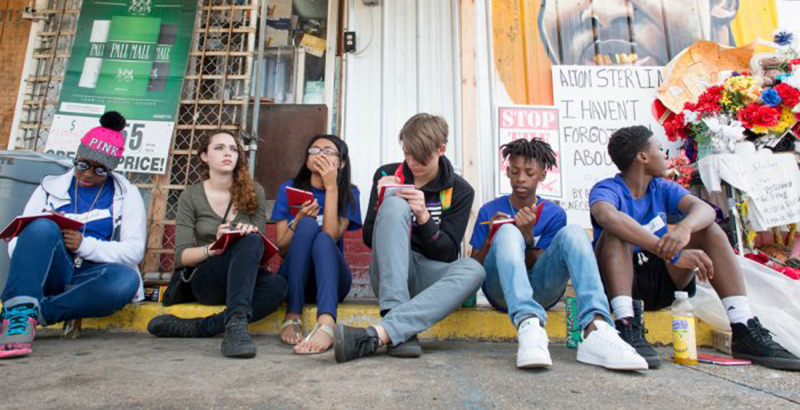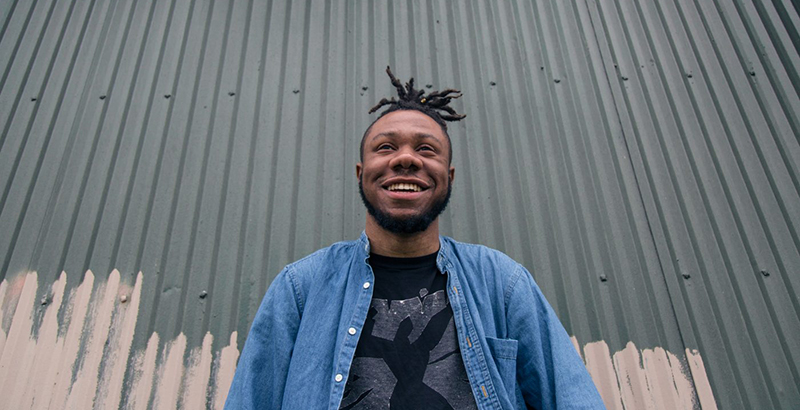Writing to Heal: NOLA Program Uses Poetry, Essays to Help Students Confront Trauma

When the bus pulled up in front of the convenience store where 37-year-old Alton Sterling was killed three months before by two Baton Rouge police officers, Nic Aziz had his students go inside and pick out something they would usually buy: candy, chips, soda pop — something seemingly inconsequential.
To do this, the 16 young people, most with little experience outside their impoverished New Orleans neighborhood, had to walk past a mural painted with Sterling’s likeness and an altar covered in flowers and photos brought by community members.
Sterling’s July 5, 2016, killing — at close range and while being held to the ground by officers who had responded to a call reporting someone with a gun making threats outside the store — was captured on video by the store’s owner and patrons. Protests engulfed Baton Rouge in the days following the shooting. In May, after the U.S. Department of Justice announced it would not prosecute the officers, Louisiana officials announced their own investigation.
As Aziz suspected they would, the teens responded to the ad hoc memorial’s fierce beauty. The kids, all students at New Orleans Charter Science and Mathematics High School, sat down outside the Triple S Food Market to write letters to Sterling.
“This is a convenience store. This is where he was killed,” Aziz recalls. “A lot of them wrote about the tragedy of it. They loved what they bought and maybe he loved it, too, and he would never get to have it again.”
Some went further, writing narrative descriptions or poems, some breaking the traditional poetic structure:
I sit here looking at awall covered in a paintingof love, of remorse, it speaksvalues of what thepeople thought of a man. Mindsvalue people of honor, people ofhope and respect. When we sit thereality of what happens sinks in, and peoplewill never forget a tragedyof the heart.Fancy cars and loud music whatam I doing here? Doesit make a difference? “Haven’tI seen enough tragedy. Forgotten”is the one thing I can accomplish and reallyif you think about it what does it mean?–Meaningful Murals, T. Childress
The trip was a “pop-up” trial for WriteBrained, a project Aziz dreamed of launching to enable youth to confront trauma through creative writing. That day’s field trip, he said several months later, went spectacularly — far better than Aziz dared dream.
The next stop was Louisiana State University, which was in the throes of homecoming weekend. “Before we even got off the bus, some students were noticing, ‘Oh, wow, this area looks completely different from the one we were just in.’ ”
One student approached an older white woman decked out in the Tigers’ purple and gold team colors. “What do you think would have happened if it was an LSU football player who had been killed and not Alton Sterling,” Aziz recalled the girl asking. He doesn’t know what was said, but the student and the woman talked amicably for some time.
The group sat down to write again, with some students documenting how it felt to step into a college campus.
“Even though the Alton Sterling site was just a few blocks away, the campus was very clean and safe. However, even though it was cleaner and safer than the Sterling site, I felt less comfortable there. Growing up in the hood, you become desensitized to things that are shocking [to] the people on the outside looking in.”
–“The Difference in a Few Blocks: A Reflection,” T. Coleman
It would seem to make total sense that Aziz, 26, would intuitively grasp the creative potential of taking a group of young people out of the familiar and encouraging them to use art to explore the resulting vulnerability. The son of a Haitian immigrant mother and a father who formerly belonged to the Nation of Islam, Aziz was seen as gifted, at the top of his class, until his mother, with the best of intentions, enrolled him in an all-boys, nearly all-white Catholic high school.
“Thankfully,” he says, “I did not finish.”
For two years, he said, his grades plummeted, and he made frequent trips to detention for things like scuffed shoes or a crooked name tag. He refers to the school now as “The Sunken Place,” an allusion to the 2017 movie about race in America Get Out. “The sunken place” is a metaphor for the self-loathing and dissonance that takes place when black people internalize white ideas about racial deficits.
Hurricane Katrina changed at least that part of Aziz’s trajectory for the better by forcing his family to evacuate. He ended up back on track thanks to a public school in Shreveport, where his mother settled temporarily, followed by Morehouse College in Atlanta and then the University of Manchester, two hours north of London, where he studied international business management.
In Manchester, he was the only black man in his graduate program, but it was completely different from high school largely, he said, because the student body was composed of people from 130 countries.

“I was like, ‘I have no friends, I’m traveling by myself,’ ” he recalls. “But the beauty was, there were so many others all having the same experience.”
Aziz wanted the experience of being prompted by new places and cultures to reconsider his identity to be shared by other New Orleans youth, like the kids he took to Baton Rouge. The inner rumblings generated by leaving one’s square on the map, he knew by then, could give birth to art with its potential to heal.
When he’s not running WriteBrained, Aziz is a visual artist. Writing, he believes, is “the most rudimentary form of art.” “Writing has really been a key to liberation for me,” he says. “Travel, college, grad school: Writing was the foundation that allowed me to do all of this.”
And so he wrote about his vision, a few paragraphs in a Word document that in the spring of 2016 became the pitch that secured his first 4.0 schools fellowship, which began in April. Over the next four months he completed a second fellowship. In October, Aziz was ready to start taking students on field trips.
After the successful Baton Rouge trip, New Orleans Charter Science and Mathematics High School agreed to make the program an after-school club for almost 20 students, with Aziz as the leader. It met every two weeks in the 2016–17 school year, taking one trip a month. Students have visited and written about a nature area in Clark Creek, Mississippi, the Whitney Plantation — the only preserved antebellum property where history is presented from the perspective of slaves — and an art project in New Orleans’s Lower Ninth Ward.
The art project, Solitary Gardens, is a series of garden plots planted on bits of land the size of solitary confinement cells, meant to make a statement about mass incarceration. Artist Jackie Sumell provides visitors a way to exchange letters with inmates who occupy the cells in Louisiana prisons — a natural extension of the students’ experience at the Triple S Food Market.
This year, WriteBrained is an in-school enrichment club that meets for a half-hour two days a week and will take 14 field trips over the course of the year. Aziz is hopeful that he’ll be able to fund another after-school program, which would give him more time with the students.
After Baton Rouge, Aziz had the students’ writings bound into a book. Their letters might be addressed to Alton Sterling, he said, but it was validating to think that their words could move others.
Dear Alton,
I know they took your life for no reason at all
And things haven’t really changed since you took your fallThey are still out there killing people with colorBut we will stand up with one anotherWe tried to bring peace to the world, but things haven’t really worked outWe still are going to fight for you and everyone without a doubt.
Sincerely,
R. Simien
—“Dear Alton,” R. Simien
Get stories like these delivered straight to your inbox. Sign up for The 74 Newsletter

;)
